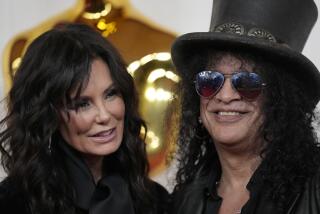A Master of the Art of Kabuki : Japanese ‘Living Treasure’ Makes Rare Overseas Appearance
For a quarter of a century, Baiko Onoe VII has been one of Japan’s “living treasures,” an officially certified master of the multiple arts of Kabuki and one of the best onnagata (performer of women’s roles) in the all-male Kabuki.
Yet, he says, he still hones his skills by practicing body movements, nude, before a mirror.
“My father was a hyper-critical man. Even in the winter, we did rehearsals in the nude before a mirror. Only that way can you understand how your entire posture looks,” said Baiko, 78, who began his stage career performing as Ushinosuke Onoe IV at age 6.
“As a man playing a woman who is dancing, you must pull your shoulder blades together to lower the shoulders and the elbows,” he observed. “The most fearsome time for an onnagata is when you turn your back to the audience. If you lose control of your posture, you will quickly be seen as a man. From the front, you are wearing makeup and you can fool others easily.”
Regularly rehearsing in the nude helps make feminine posture “a part of you,” he said.
Baiko will display the result of such rehearsals in a rare overseas performance Thursday through Sunday in Los Angeles. He will be part of a 45-member troupe from the Grand Kabuki performing at the Japan America Theatre, which is commemorating its 10th anniversary season.
Baiko said he looks forward to a better setting than when he last performed in Los Angeles in 1969 at the outdoor Greek Theatre. Each night, just at the moment when his character committed suicide by stabbing himself in the stomach with a sword, a regularly scheduled airplane roared overhead, he recalled unhappily.
His upcoming Los Angeles visit will reunite him with Faubion Bowers, whom Baiko regards as the savior of post-World War II Kabuki. Bowers, a New Yorker, will come to Los Angeles to act as translator, the artist said.
A Kabuki fan from prewar days, Bowers was a lieutenant assigned in 1945 to serve as an assistant to Gen. Douglas A. MacArthur, the Occupation commander. Bowers worked his way into the position of the Occupation’s artistic censor. He, step by step, lifted a ban his predecessors had imposed on “feudal” plays. “That we have Kabuki as it exists today is because of Bowers,” Baiko said.
Bowers translated entire scripts of Kabuki plays, including even words of songs, so Occupation authorities could understand that Kabuki was not perpetrating militarism--”an incredible (linguistic) achievement,” Baiko said.
Indeed, so ancient is the language of some Kabuki classics that ordinary Japanese cannot understand it. By 1970 or so, audiences were dwindling to the point that alarm was being expressed for Kabuki’s survival.
“People who don’t understand it have no interest in it,” Baiko said, crediting Kabuki’s revival to the practice of offering explanations in modern Japanese through earphones.
But others say it was the appearance of Kabuki actors--Baiko’s son, Kikugoro Onoe VII, among them--in television dramas and modern stage plays that attracted public attention back to the ancient art. Now, Kabuki is enjoying a boom.
Baiko worries still, observing: “Japanese easily get hot and cold on anything.”
The old art, he says, teaches “humility and a respect for etiquette” and conveys traditional values, such as giri and ninjo (obligation and human empathy) that, Baiko complains, have disappeared from the younger generations in Japan today.
“That’s sad,” he said, blaming youth for confusing post-World War II “freedom with the idea that doing whatever one wants to do--without assuming responsibility for one’s actions--is all right.”
A supply of major actors, he says, is assured by the Kabuki practice of family succession. His family can trace its roots in Kabuki for seven generations. He himself was adopted into a Kabuki family and trained from childhood for the stage as an onnagata. Now, about one of every 10 roles he plays is that of a man.
One of his two sons, Kikugoro Onoe VII, is a renowned actor; two of his five grandchildren have entered the theater--a grandson into Kabuki and a granddaughter into stage drama.
A former South Korean government official to whom he presented a stage photograph of himself once asked, “Why are you giving me a photograph of your wife?” But there is nothing feminine about Baiko off stage. Appearing at least 10 years younger than his age, he exudes an impression of a distinguished but humble company president.
What sets him apart is his striving for perfection.
Although he has played so many hundreds of roles that he can’t even remember the number, Baiko proclaims that he knows “fewer than 10” well enough to take to the stage without major rehearsals. Working eight months a year, he is still taking on new roles. In April, acting with his grandson, Ushinosuke, he assumed a part in “Chushingura”; he had never done the role in the Japanese classic, which is about the revenge and suicide of a feudal lord’s 47 loyal warriors.
Form dominates Kabuki. But to Baiko, heart is what counts--in Kabuki or any form of art.
“From the moment I start to apply makeup, I become the woman I am to portray,” he says. “My predecessor as Baiko was 170 centimeters (5-feet-7) tall. I am about 160 centimeters (5-feet-3). I chose a form suitable for myself. But the heart that goes into the acting remains the same.
“As an onnagata, I have to have three styles--for a young maiden, for a middle-aged woman, and for an old woman. But if I don’t become a maiden, a middle-aged woman or an old woman down to the very tip of my forefinger, it’s no good. If you are just presenting a form--with no feeling, no heart--you are just a doll. There is no impact,” he said.
* Grand Kabuki of Japan will perform Thursday through Sunday at the Japan America Theatre, 244 S. San Pedro St., Los Angeles. Shows are at 8 p.m. Thursday; 3 p.m. and 8 p.m. Friday-Saturday, and 2 p.m. and 7 p.m. Sunday. Information: (213) 628-2725. Chiaki Kitada of The Times’ Tokyo bureau contributed to this story.
More to Read
The biggest entertainment stories
Get our big stories about Hollywood, film, television, music, arts, culture and more right in your inbox as soon as they publish.
You may occasionally receive promotional content from the Los Angeles Times.






